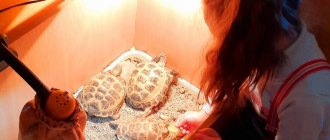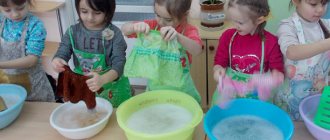MAGAZINE Preschooler.RF
From the experience of working “At the Center of the Book”- Voronkova Natalya Anatolevna
- Frolova Natalya Viktorovna
Teacher at Municipal Educational Institution Kindergarten No. 254, Volgograd
Modern children spend a lot of time near the TV and have completely lost interest in reading. Parents don’t have time to read with their children; it’s easier to buy a new CD with cartoons and the child will be busy watching it all evening. Faced with the problem of little interest in books among students, we organized a book center in the group. Not like everyone else’s in kindergartens - ordinary shelves with children’s literature. We tried to make this an unusual place that every child would always be interested in visiting. Introducing children to reading allows them to increase their interest in everything that surrounds them, introduce them to the culture of Russia, and learn wise truths that provide an example of attitude towards nature, family, clan, and Motherland. Working in the center of the book helps stimulate the development of speech, better adapt to practical life, and learn to understand many phenomena of the world around us.
Target group: children 4-7 years old with mental retardation and general speech underdevelopment. The leading educational area of the program, implemented in various types of activities at the Book Center , is speech development.
Every day, in the center of the book, we read different works, play games - dramatizations based on the plots of familiar works, looking at illustrations in books. We teach the strict rule of careful handling of books. In order to introduce children to work and develop fine motor skills, we carry out book repair activities. We have an “First Aid for a Book” , which contains everything you need for repairs: glue, tape, scissors, strips of paper, eraser. One of the students’ favorite activities is illustrating literary works. The center has everything for artistic activities. After each reading of the book we make sketches. After each reading, we try to conduct an analysis conversation to find out what we liked best and what we remember.
L. Vygotsky said: It is not reading itself that influences, but the child’s experience during the reading process that influences his development.
Let's find out which hero is good and which is bad in the children's opinion. Which actions of the heroes can be repeated and which cannot. The guys themselves express who they want to be like. We often imagine what a different ending could a fairy tale or story have. Depending on the season, lexical topic, and upcoming holidays, we certainly change the literature. There are many poems about the seasons that we learn by heart. Many works are presented in several versions (different editions), several identical copies, so that children can simultaneously observe the illustrations and compose their own retellings. And sometimes someone just wants to look through exactly the same book. Be sure to turn on additional lighting in the evening. There is also a small place for privacy in our center. This is an umbrella that is attached to the ceiling on a string, it is covered with a canopy, you can go into the middle, cover the canopy and be alone. There is an ottoman inside where you can sit and remember the familiar lines of the poem.
When organizing the center, we adhered to the principle of satisfying the diverse interests of children. We have books and encyclopedias about the animal world - for lovers of all living things. Russian folk tales and those of the world, poems, stories, pictures by illustrators, baby books, encyclopedias from the “I want to know everything” and much more.
Every day we get acquainted with new books. After reading the book, children can express everything that they felt in creative activities: making fairy tale characters, dramatizing fairy tales, working with coloring books, dramatizing fairy tales using the mitten theater, inventing fairy tales using ring dolls, working with flannelograph, dramatizing a read fairy tale using different types of theaters. We consider our achievements to be a performance in front of pupils of other groups with a production based on the fairy tale by A. Pushkin “About the Fisherman and the Fish” , with a production based on the fairy tale “Zayushkina’s Hut” , where the children were able to feel like artists. The music director provided us with invaluable assistance by selecting the musical accompaniment and providing costumes. We regularly conduct direct educational activities on speech and cognitive development in the center of the book. Since our group is attended by children diagnosed with mental retardation, classes are held in subgroups, so we can accommodate the center freely. There are tables, a screen for the theater, and sets of various dolls - mittens, rings, bi-ba-bo, wooden figures, cardboard ones for flannelgraphs, rubber ones, and stompers. The classes conducted are developmental in nature, ensuring maximum activity and independence of the learning process. They are carried out in a certain system and have a connection with the everyday life of children.
For example, a fragment of a lesson on familiarizing yourself with a book. Educator: “There are different books: about nature, stories, fairy tales, poems. What books have you read: about nature?, fairy tales?, poetry? (Children's answers.) Do you know the difference between stories and fairy tales, and poems from short stories? (Children's answers.) Tell me guys, who writes stories? poetry? fairy tales? (Children's answers: writer, poet, storyteller.) There are books that help us, teach us. How many of you know what kind of book this is? What books help us learn to draw? (Coloring pages.) When you go to school, kids will come to our group. We need to leave the books in perfect order for them. People have always valued and cherished books. Parents gave books to their children. They say that “reading is the best learning” and that . ” Do you understand what these proverbs are saying? (Children's answers.) There are many riddles about books, for example:
Not a tree, but with leaves, Not a shirt, but sewn, Not a field, but sown, Not a man, but a storyteller.
Books love cleanliness and order, they help you learn a lot of new things. The work of a person is invested in the book, they need to be protected.
For parents, we provide information on choosing literature to read at home.
We are known in the area, we participate in development environment competitions, representing our center. If necessary, our book center can easily be transformed into a mini-museum “Russian Upper Room” . Museum exhibits are stored in the closet: real bast shoes, a spindle, a samovar, clay pots, felt boots and much more. These exhibits often come in handy when reading works to introduce children to Russian antique objects, utensils, clothing, etc. Children get acquainted with Russian rituals, songs, nursery rhymes, games, folk holidays, songs, and chants. In this way, we solve two important problems at once - we introduce people to reading and introduce them to Russian culture.
| Next > |
Multi-level order
The multi-level model of children's libraries is especially in demand. When the reading space is organized according to the following principles:
- availability of books;
- visibility of decorated stands and corners;
- an original organized space to ensure information content and interest.
For each age group of the children's corner in the children's library, a specific zone is allocated, but without “hard boundaries” so that the reader can freely change levels if he wants.
At the same time, educational excursions to libraries are recommended for the little ones. During them, readers are shown how a library card is issued, how books are issued, how long it takes to read them, and when and in what form they need to be returned.
Libraries, designed to accommodate different reading interests, are always full of visitors. In the photo you see an example of successful zoning, which allows not only children, but also adults to have an interesting time in the children's library.
Choosing books for a children's library
The range of children's literature today is very large. It's easy to buy an expensive book and miss the plot or illustrations. To avoid such troubles (and ineffective spending), try to consider the following points when purchasing:
leaf through the book carefully. If possible, skim a few pages to understand how close the book’s style, the author’s language, etc. are to you; choose books with illustrations in natural colors. This is very important for babies; Glossy pages are considered the highest quality, but they are not always convenient during the reading process - glowing pages often spoil the impression; Encyclopedias are a separate type of books. They are often leafed through, so the pages must be durable and the drawings must be bright and large. A good encyclopedia is a real decoration for a library and an excellent gift.
Portrait of modern readers
Many modern institutions of this profile manage to break the stereotypes that the library is boring, and there is nothing to look for there except dust and disgruntled librarians.
In fact, despite the era of popularization of electronic books, more and more readers are drawn to paper publications, go to reading rooms, and while away their free evening or night time in the library. And this is not surprising, because more and more people from the working outskirts go to the library. What attracts them? Firstly, it’s the pleasure of communicating with fellow readers. Secondly, the pleasure is free. Thirdly, the development of the intellectual level has never bothered anyone.
The children's corner in the children's library deserves special attention from readers. After all, the most frequent visitors today are parents with children. The child reads a book, and the parents go to a club of interests, right there in the library.
Of course, not all institutions have rooms for adults and children at the same time. But, for example, you can create a special, fairy-tale or simply non-standard and creative corner to attract children even in a small library. The photo shows a children's corner in the library, the design of a reading room with the organization of a play area, a place for listening to music or reading.
Creating your own kindergarten logo is very easy
Where to begin
Enter your company name and choose logo styles, colors and symbols - it only takes 2 minutes!
Our AI-powered logo maker will use your preferences to create design options.
Select
You will be presented with hundreds of different logo designs based on your wishes.
Add a few of them to your favorites and see how they look on t-shirts, business cards and more.
Bring it to perfection
Use our dedicated editor to refine your design and bring your vision to life.
You can easily change colors, fonts, shapes and sizes - no design skills required!
Turn your creative vision into a brand you can be proud of. Proceed to creating a logo.
Creating a rubricator
A rubricator, even a conditional one, is needed primarily for uniform replenishment of the library’s contents. With it, it will be easier for you to keep track of which books there are a lot of, and which ones not so much, what exactly you need to buy for an older child.
The rubricator can be implemented in different ways. In most cases, parents simply allocate a separate place on the shelves for each direction.
The most common categories of books found in home libraries are:
books for little ones; Russian folk tales, poems by Russian poets; fairy tales and poems by Soviet writers; fairy tales by foreign authors; anthologies, tales of the peoples of the world, legends and myths; books about children; adventure library; encyclopedias; books for preschoolers; educational literature and manuals for teaching children; classic books for older children.
The specific content of each category depends on your preferences. You can be guided only by your impression and spend hours near the shelves in a bookstore. A more humane way is to read book reviews and read reader reviews before purchasing.




